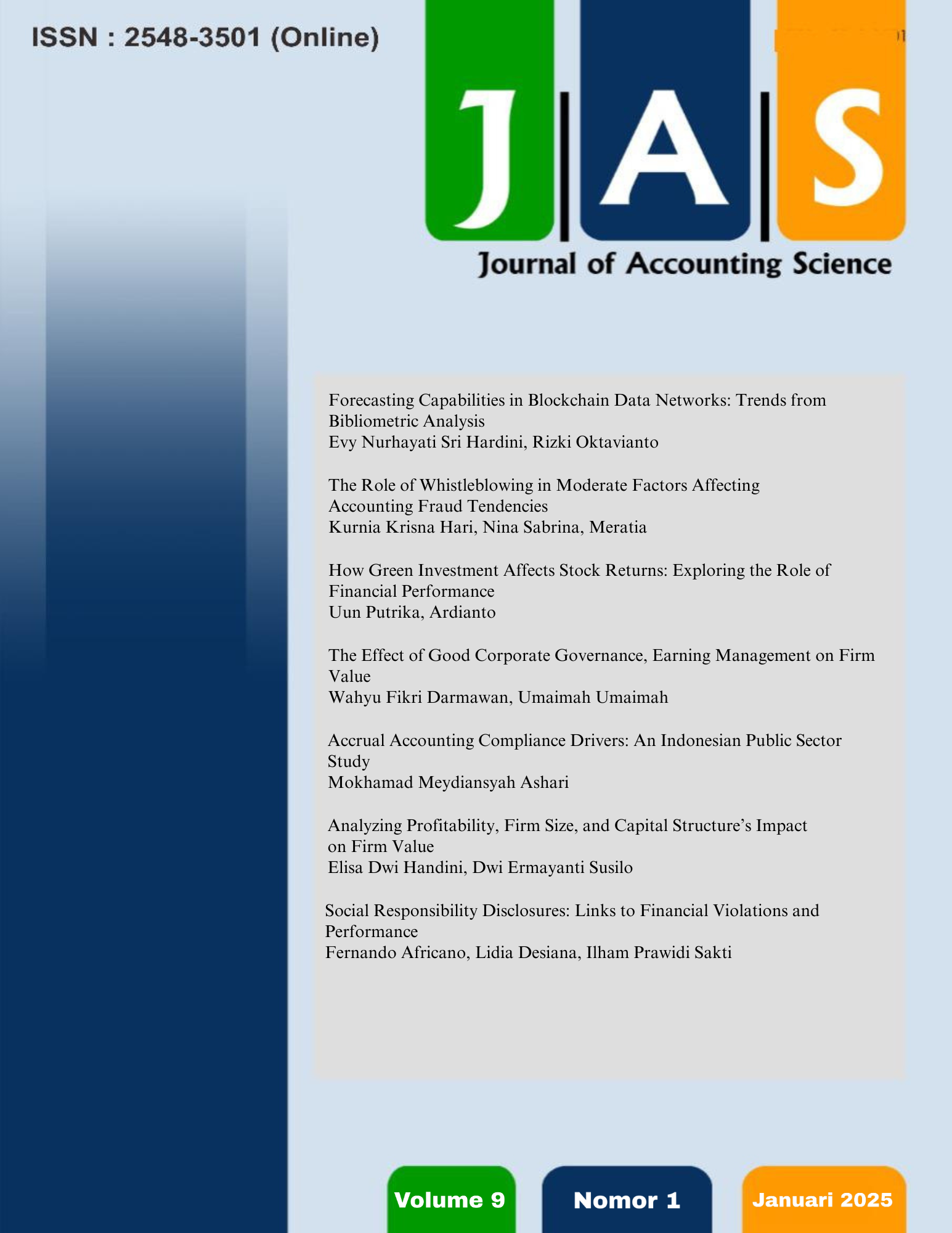Forecasting Capabilities in Blockchain Data Networks: Trends from Bibliometric Analysis
DOI:
https://doi.org/10.21070/jas.v9i1.1828Keywords:
Bibliometric, Blockchain, Business, ForecastingAbstract
General Background: Blockchain technology has gained significant global attention due to its potential to enhance transparency, security, and efficiency in various domains, including business forecasting. Specific Background: The integration of blockchain into forecasting mechanisms can improve supply chain efficiency, inventory management, and market demand prediction. Knowledge Gap: Despite its potential, limited research has systematically examined blockchain's role in forecasting capabilities, particularly through a bibliometric analysis approach. Aims: This study employs R Studio and VOSviewer to analyze bibliometric data from Scopus, aiming to identify trends, influential publications, and research gaps in blockchain-based forecasting. Methods: A systematic bibliometric analysis was conducted on 287 relevant articles published between 2015 and 2023, focusing on citation networks, keyword co-occurrence, and thematic clustering. Results: The findings indicate that forecasting is a dominant research theme, with China contributing the most publications. Key studies highlight blockchain's role in cryptocurrency prediction, supply chain management, and decentralized finance. Novelty: This research provides the first comprehensive bibliometric mapping of blockchain-based forecasting, revealing emerging trends and future directions. Implications: The study informs businesses, policymakers, and researchers on leveraging blockchain for predictive analytics, offering insights for enhancing decision-making in finance, trade, and supply chain management.
Downloads
References
Abioye, S. O., Oyedele, L. O., Akanbi, L., Ajayi, A., Davila Delgado, J. M., Bilal, M., Akinade, O. O., & Ahmed, A. (2021). Artificial intelligence in the construction industry: A review of present status, opportunities, and future challenges. Journal of Building Engineering, 44(August), 103299. https://doi.org/10.1016/j.jobe.2021.103299
Akrami, N. El, Hanine, M., Flores, E. S., Aray, D. G., & Ashraf, I. (2023). Unleashing the Potential of Blockchain and Machine Learning: Insights and Emerging Trends from Bibliometric Analysis. IEEE Access, June, 78879–78903. https://doi.org/10.1109/ACCESS.2023.3298371
Ali, O., Ally, M., & Dwivedi, Y. (2020). The state of play of blockchain technology in the financial services sector: A systematic literature review. International Journal of Information Management, 54. https://doi.org/10.1016/j.ijinfomgt.2020.102199
Butler, C., & Crane, M. (2023). Blockchain transaction fee forecasting: a comparison of machine learning methods. Mathematics, 11(9), 2212. https://doi.org/10.3390/math11092212
Casino, F., Dasaklis, T. K., & Patsakis, C. (2019). A systematic literature review of blockchain-based applications: Current status, classification, and open issues. Telematics and Informatics, 36(November 2018), 55–81. https://doi.org/10.1016/j.tele.2018.11.006
Chen, X., Ji, J., Luo, C., Liao, W., & Li, P. (2019). When Machine Learning Meets Blockchain: A Decentralized, Privacy-preserving and Secure Design. Proceedings - 2018 IEEE International Conference on Big Data, Big Data 2018, 1178–1187. https://doi.org/10.1109/BigData.2018.8622598
Comerio, N., & Strozzi, F. (2019). Tourism and its economic impact: A literature review using bibliometric tools. Tourism Economics, 25(1), 109–131. https://doi.org/10.1177/1354816618793762
Di Francesco Maesa, D., & Mori, P. (2020). Blockchain 3.0 applications survey. Journal of Parallel and Distributed Computing, 138, 99–114. https://doi.org/10.1016/j.jpdc.2019.12.019
Ding, Y., & Cronin, B. (2011). Popular and prestigious? Measures of scholarly esteem. Information Processing and Management, 47(1), 80–96. https://doi.org/10.1016/j.ipm.2010.01.002
Donthu, N., Kumar, S., Mukherjee, D., Pandey, N., & Lim, W. M. (2021). How to conduct a bibliometric analysis: An overview and guidelines. Journal of Business Research, 133(April), 285–296. https://doi.org/10.1016/j.jbusres.2021.04.070
Firdaus, A., Razak, M. F. A., Feizollah, A., Hashem, I. A. T., Hazim, M., & Anuar, N. B. (2019). The rise of “blockchain”: bibliometric analysis of blockchain study. In Scientometrics (Vol. 120, Issue 3). Springer International Publishing. https://doi.org/10.1007/s11192-019-03170-4
Gasparyan, A. Y., Ayvazyan, L., & Kitas, G. D. (2013). Multidisciplinary bibliographic databases. Journal of Korean Medical Science, 28(9), 1270–1275. https://doi.org/10.3346/jkms.2013.28.9.1270
Ho, H. (2018). Trade finance: An introduction to the key challenges.
Iansiti, Marco & Lakhani, K. (2017). T. T. A. B. H. business review. 95. 118-127. (2006). The Truth About Blockchain. Annals of Tourism Research, 33(2), 360–381. https://hbr.org/2017/01/the-truth-about-blockchain
Karafiloski, E. & Mishev, A. (2017). Blockchain Solutions for Big Data Challenges. IEEE EUROCON 17th International Conference, July, 763–768.
Kemdikbud. (2022). Program Kampus Merdeka. https://kampusmerdeka.kemdikbud.go.id/
Kowalski, M. (2021). Blockchain technology and trust relationship in trade finance. Technological Forecasting and Social Change.
Kumar, S., Lim, W. M., Sivarajah, U., & Kaur, J. (2023). Artificial Intelligence and Blockchain Integration in Business: Trends from a Bibliometric-Content Analysis. Information Systems Frontiers, 25(2), 871–896. https://doi.org/10.1007/s10796-022-10279-0
Lee, D., Lee, S. H., Masoud, N., Krishnan, M. S., & Li, V. C. (2021). Integrated digital twin and blockchain framework to support accountable information sharing in construction projects. Automation in Construction, 127(July 2020), 103688. https://doi.org/10.1016/j.autcon.2021.103688
Liang, C., Zhang, Y., Li, X., & Ma, F. (2022). Which predictor is more predictive of Bitcoin volatility? And why? International Journal of Finance & Economics, 27(2), 1947-1961. https://doi.org/10.1002/ijfe.2252
McBee, M. P., & Wilcox, C. (2020). Blockchain Technology: Principles and Applications in Medical Imaging. Journal of Digital Imaging, 33(3), 726–734. https://doi.org/10.1007/s10278-019-00310-3
Nakamoto, S. (2008). Bitcoin: A Peer-to-Peer Electronic Cash System. https://doi.org/10.1108/TG-06-2020-0114
Pazaitis, A., De Filippi, P., & Kostakis, V. (2017). Blockchain and value systems in the sharing economy: The illustrative case of Backfeed. Technological Forecasting and Social Change, 125(March), 105–115. https://doi.org/10.1016/j.techfore.2017.05.025
Pournader, M., Ghaderi, H., Hassanzadegan, A., & Fahimnia, B. (2021). Artificial intelligence applications in supply chain management. International Journal of Production Economics, 241(July 2020), 108250. https://doi.org/10.1016/j.ijpe.2021.108250
Rikhardsson, P., & Yigitbasioglu, O. (2018). Business intelligence & analytics in management accounting research: Status and future focus. International Journal of Accounting Information Systems, 29(March), 37–58. https://doi.org/10.1016/j.accinf.2018.03.001
Rogers, E.M. (2003). Diffusion of innovations (5th ed.). New York: Free Press
Sadri, H., Yitmen, I., Tagliabue, L. C., Westphal, F., Tezel, A., Taheri, A., & Sibenik, G. (2023). Integration of Blockchain and Digital Twins in the Smart Built Environment Adopting Disruptive Technologies—A Systematic Review. Sustainability (Switzerland), 15(4). https://doi.org/10.3390/su15043713
Salah, K., Rehman, M. H. U., Nizamuddin, N., & Al-Fuqaha, A. (2019). Blockchain for AI: Review and open research challenges. IEEE Access, 7(c), 10127–10149. https://doi.org/10.1109/ACCESS.2018.2890507
Shermin, V. (2017). Disrupting governance with blockchains and smart contracts. Strategic Change, 26(5), 499–509. https://doi.org/10.1002/jsc.2150
Soleymani, F., & Paquet, E. (2020). Financial portfolio optimization with online deep reinforcement learning and restricted stacked autoencoder—DeepBreath. Expert Systems with Applications, 156, 113456. https://doi.org/10.1016/j.eswa.2020.113456
Sun, X., Liu, M., & Sima, Z. (2020). A novel cryptocurrency price trend forecasting model based on LightGBM. Finance Research Letters, 32(December 2018). https://doi.org/10.1016/j.frl.2018.12.032
Thakkar, P. (2019). How Blockchain is Redefining the Rules of Supply Chain. BOSS Magazine. https://thebossmagazine.com/blockchain%02supply-chain/
Van Eck, N. J., & Waltman, L. (2010). Software survey: VOSviewer, a computer program for bibliometric mapping. Scientometrics, 84(2), 523–538. https://doi.org/10.1007/s11192- 009-0146-3
Wang, S., Ni, X., Yuan, Y., Wang, F. Y., Wang, X., & Ouyang, L. (2018, July). A preliminary research of prediction markets based on blockchain powered smart contracts. In 2018 IEEE International Conference on Internet of Things (iThings) and IEEE Green Computing and Communications (GreenCom) and IEEE Cyber, Physical and Social Computing (CPSCom) and IEEE Smart Data (SmartData) (pp. 1287-1293). IEEE. 10.1109/Cybermatics_2018.2018.00224
Wang, Y., Wei, Y., Lucey, B. M., & Su, Y. (2023). Return spillover analysis across central bank digital currency attention and cryptocurrency markets. Research in International Business and Finance, 64, 101896. Werbach, K. (2018). Trust, but Verify: Why the Blockchain needs the law. https://doi.org/10.1016/j.ribaf.2023.101896
World Economic Forum. (2015). Deep Shift Technology Tipping Points and Societal Impact. http://www3.weforum.org/docs/WEF_GAC15_Technological_
Yang, F., Qiao, Y., Wang, S., Huang, C., & Wang, X. (2021). Blockchain and multi-agent system for meme discovery and prediction in social network. Knowledge-Based Systems, 229, 107368. https://doi.org/10.1016/j.knosys.2021.107368
Yin, H. H. S., Langenheldt, K., Harlev, M., Mukkamala, R. R., & Vatrapu, R. (2019). Regulating Cryptocurrencies: A Supervised Machine Learning Approach to De-Anonymizing the Bitcoin Blockchain. Journal of Management Information Systems, 36(1), 37–73. https://doi.org/10.1080/07421222.2018.1550550
Yong, B., Shen, J., Liu, X., Li, F., Chen, H., & Zhou, Q. (2020). An intelligent blockchain-based system for safe vaccine supply and supervision. International Journal of Information Management, 52(November 2019), 102024. https://doi.org/10.1016/j.ijinfomgt.2019.10.009
Yoo, S. (2017). Blockchain based financial case analysis and its implications. Asia Pacific Journal of Innovation and Entrepreneurship, 11(3), 312-321. https://doi.org/10.1108/APJIE-12-2017-036
Zheng, Z., Xie, S., Dai, H., Chen, X., & Wang, H. (2017). An Overview of Blockchain Technology: Architecture, Consensus, and Future Trends. Proceedings - 2017 IEEE 6th International Congress on Big Data, BigData Congress 2017, 557–564. https://doi.org/10.1109/BigDataCongress.2017.85
Zhong, P., Zhong, Q., Mi, H., Zhang, S., & Xiang, Y. (2019). Privacy-Protected Blockchain System. Proceedings - IEEE International Conference on Mobile Data Management, 2019-June(Mdm), 457–461. https://doi.org/10.1109/MDM.2019.000-2
Zhu, X. N., Peko, G., Sundaram, D., & Piramuthu, S. (2022). Blockchain-Based Agile Supply Chain Framework with IoT. Information Systems Frontiers, 24(2), 563–578. https://doi.org/10.1007/s10796-021-10114-y





